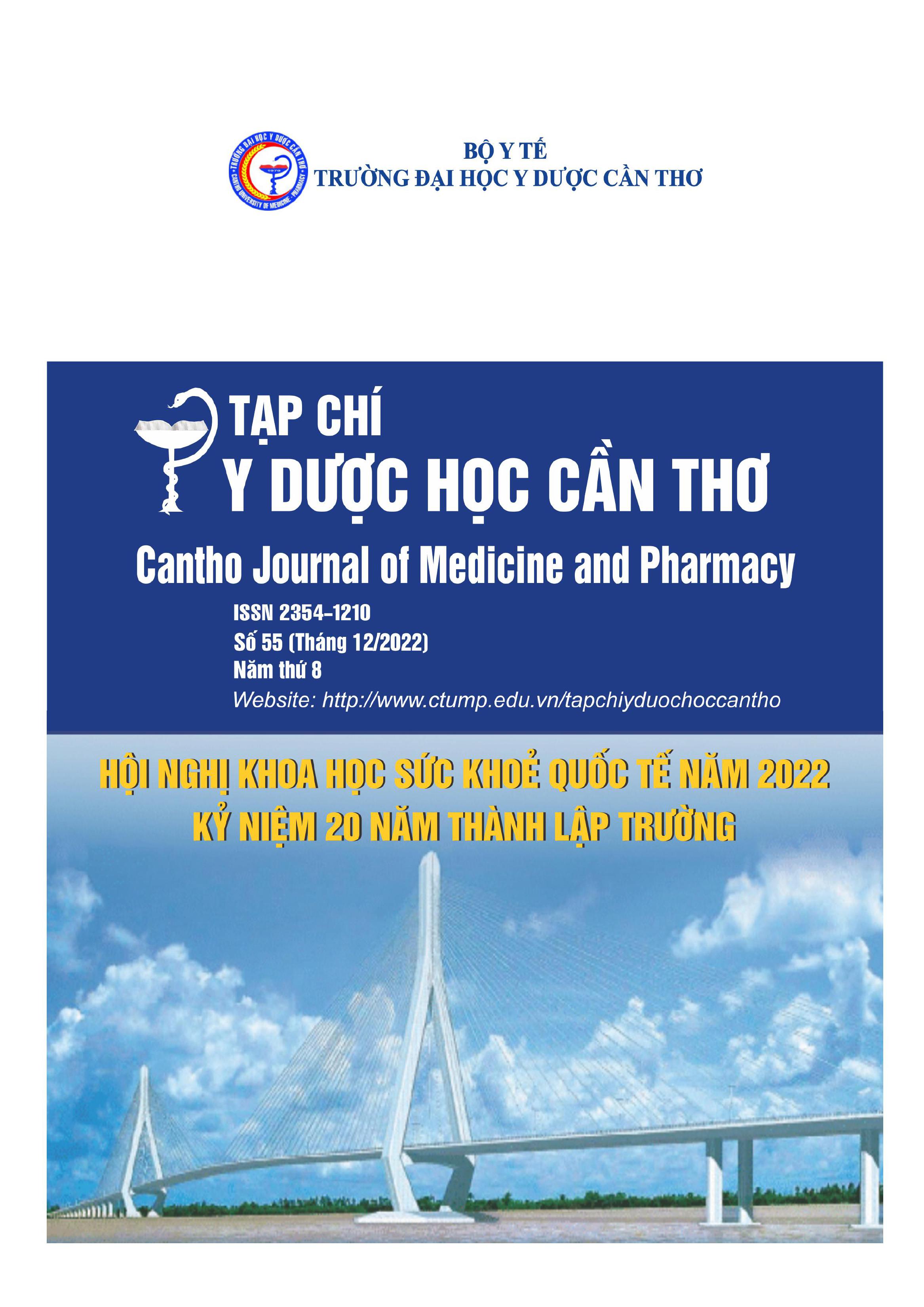EARLY OUTCOMES OF THORACO – LAPAROSCOPIC ESOPHAGECTOMY FOR ESOPHAGEAL CANCER AT CAN THO UNIVERSITY OF MEDICINE AND PHARMACY HOSPITAL
Main Article Content
Abstract
Background: Minimally invasive esophagectomy (MIE) has proved to be safe with lower morbidity, lower mortality (1.4 – 1.9%), short duration of hospitalization, and similar oncological outcomes. Objective: To evaluate the early outcomes of thoracic-laparoscopic esophagectomy for treating esophageal cancer at the Department of General Surgery of Can Tho University of Medicine and Pharmacy Hospital. Materials and methods: A retrospective and prospective descriptive study on 31 patients undergoing MIE at Can Tho University of Medicine and Pharmacy Hospital from January 2015 to October 2022. Results: 31 esophageal cancer patients were male, the median age was 60.16±9.64 years (37-80 years). All cases were successfully performed, 30 cases with anastomosis in the neck, and 1 case with anastomosis in the thorax. The median duration of surgery was 474.35±86.68 minutes. There was one case of tracheal injury (3.2%), which was viewed and managed at operation. Postoperative morbidity was 64.5%: respiratory complications 54.8%, leakage of anastomosis 9.7%, dysphonia 12.9%, and mortality 3.2%. The median postoperative hospital stay was 18.26±5.1 days. The average number of harvested lymph nodes: is 8.9±3.83 nodes. Postoperative pathological results: squamous cell carcinoma 87.1%, adenocarcinoma 9.7%, and in almost all cases were moderately differentiated, 69%. Conclusion: Laparo-thoracoscopic esophagectomy for the treatment of esophageal cancer was a safe method that has acceptable morbidity and mortality.
Article Details
Keywords
Esophageal cancer, esophagectomy, thoraco-laparoscopic
References
2. Phạm Đức Huấn, (2016), Đánh giá kết quả phẫu thuật cắt thực quản nội soi ngực bụng, vét hạch rộng hai vùng với tư thế sấp nghiêng 30 độ, Hội nghị khoa học Ngoại khoa và phẫu thuật nội soi toàn quốc.
3. Trần Mạnh Hùng (2021), Kết quả bước đầu phẫu thuật nội soi qua hai đường ngực - bụng điều trị ung thư thực quản tại Bệnh viện Bạch Mai, Tạp chí Y học Việt Nam, 501(2), tr. 58-61.
4. Hoàng Trọng Nhật Phương, Lê Lộc, Phạm Như Hiệp, (2013), Đánh giá kết quả phẫu thuật cắt thực quản nội soi ngực trong điều trị ung thư thực quản, Hội nghị ngoại khoa toàn quốc, Cần Thơ.
5. Trịnh Viết Thông (2018), Nghiên cứu ứng dụng phẫu thuật nội soi lồng ngực và ổ bụng điều trị ung thư thực quản ngực, Luận án Tiến sỹ Y học, Trường Đại học Y Hà Nội.
6. Phan Thanh Tuấn, Đỗ Minh Hùng, Nguyễn Phú Hữu, và cs. (2016), Kết quả sớm phẫu thuật nội soi ngực bụng cắt thực quản nạo hạch hai vùng với tư thế nằm sấp, Hội Nghị Khoa Học Kỹ Thuật Bệnh viện Bình Dân, Bệnh viện Bình Dân.
7. Phạm Trung Vỹ, Phạm Như Hiệp, Hồ Hữu Thiện, và cộng sự. (2020), Phẫu thuật nội soi ngực bụng trong điều trị ung thư thực quản, Tạp Chí Y Học Lâm Sàng, 66, tr. 44-49.
8. Akiyama H, Tsurumaru M, Udagawa H, et al. (1994), Radical lymph node dissection for cancer of the thoracic esophagus, Annals of Surgery, 220(3), pp. 364.
9. Chowdappa R, Dharanikota A, Arjunan R, et al. (2021), Operative Outcomes of Minimally Invasive Esophagectomy versus Open Esophagectomy for Resectable Esophageal Cancer, South Asian Journal of Cancer, 10(04), pp. 230-235.
10. Decker G, Coosemans W, Leyn PL, et al. (2009), Minimally invasive esophagectomy for cancer, European Journal of Cardio-thoracic Surgery, 35(1), pp. 13-21.
11. Miyasaka D, Okushiba S, Sasaki T, et al. (2013), Clinical evaluation of the feasibility of minimally invasive surgery in esophageal cancer, Asian Journal of Endoscopic Surgery, 6(1), pp.26-32.
12. Pather K, Mobley EM, Guerrier C, et al. (2022), Long-term survival outcomes of esophageal cancer after minimally invasive Ivor Lewis esophagectomy, World Journal of Surgical Oncology, 20(1), pp.1-14.
13. Smithers BM, Gotley DC, McEwan D, et al. (2001), Thoracoscopic mobilization of the esophagus, Surgical Endoscopy, 15(2), pp.176-182.
14. Takahashi C, Shridhar R, Huston J, et al. (2018), Esophagectomy from then to now, J Gastrointest Oncol, 9(5), pp. 903-909.
15. Watanabe M, Baba Y, Nagai Y, et al. (2013), Minimally invasive esophagectomy for esophageal cancer: an updated review, Surg Today, 43(3), pp.237-244.


